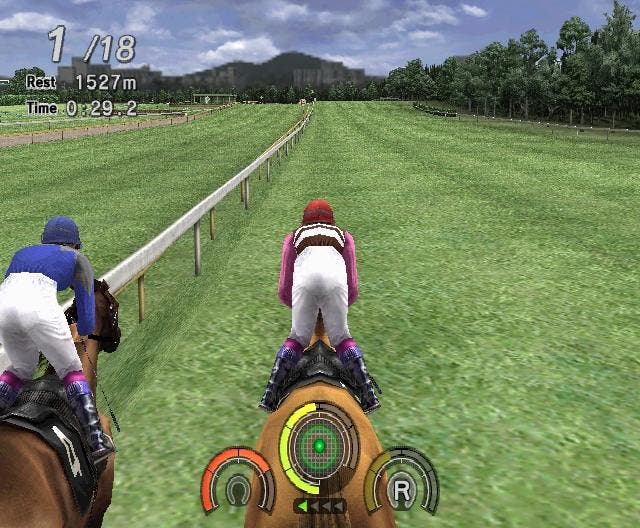G1 Jockey Wii
Horse play.
The controls are, happily, more simple. You hold the Nunchuck in your left hand and angling this forward makes your jockey drive the horse while angling it backwards makes the jockey pull back. Double clicking the C button changes your horse's lead leg (essential when entering and exiting turns) while holding the Z-button initiates a strong drive - perfect for pushing towards the finishing line. In your right hand you hold the Wii controller and flicking it from side to side whips your horse. There are three variations of whip types but, for the most part, the straightforward side-to-side version will do the trick of kicking your horse up a gear.
Outside of races the game is equally as onion-layered. Once graduating from jockey school you join a stable, which, earn a good reputation as a winning jockey, offers you different horses to race. It's possible to race horses for other stables by paying for the privilege out of a bank of tokens which you receive for wins. As you gain credibility and fame you earn the chance to ride in faster ranked races (all the way up to the eponymous G1 series). Winning races is tricky to begin with and your fist actual win will be an ecstatic moment. Indeed, it's refreshing to play a racing game where finishing third feels like something of an achievement (and is praised by the NPCs) rather than seeming an abject failure.

After your first couple of hours play your stable's trainer will call you in to the stables to offer you the chance to breed your own horse. Every January you're given the chance to select two horses from a huge list of different types and styles to breed. Their resulting offspring is given to you to train up in order to race for the stable when it matures. Once you've named your new horse you're allowed to train it once a week in order to improve each of its 20 different attributes. You pick which attribute you want to level up and undertake a challenge mini-game based around that skill (e.g. running three furlongs at 13 second per furlong to increase control). How well you do in the challenge dictates how much that statistic increases for the week and so, the better you are at completing minigames the faster your new horse will develop. You have up until the month before the horse's first race debut to improve its statistics so the emphasis is on performing well in mini-games to get the horse as good as possible before you start racing it professionally.
While this all sounds a little complex (and the above isn't even explained in the manual) in fact its extremely compelling as you struggle to match target times for furlongs, attempt to get the best possible starts out of the gate and generally work hard to improve your horse before the deadline. You then race this horse in the next season, as well as receiving a new foal to train up, so as the game progresses you find that, more and more, you're racing foals, which you trained from birth. In this way the game becomes increasingly personal as it progresses, thus sinking its claws into you as you seek to do the very best you can for your stable of equestrian Tamagotchi.

G1 Jockey Wii arrives with fortuitous timing. The Wii's release schedule is characteristically sparse and, as such, this niche game, which normally would be bypassed by most critics and consumers will draw more attention and sales than it would on another platform. For open-minded Wii gamers desperately seeking something, anything, this game unexpectedly fills the gap. Learning to play the game is in many ways like learning a new language: once its constructions are understood and the required muscle memory absorbed, the game establishes a satisfying rhythm. As with all games, the subject and theme eventually fades and the quality of the design that lies beneath reveals itself. Koei demonstrate here that they know how to make an accurate horse racing sim. But, far more importantly, they demonstrate excellence at structuring an enjoyable and compelling videogame, one that will entrance those with eyes to see, and curtains to conceal.








